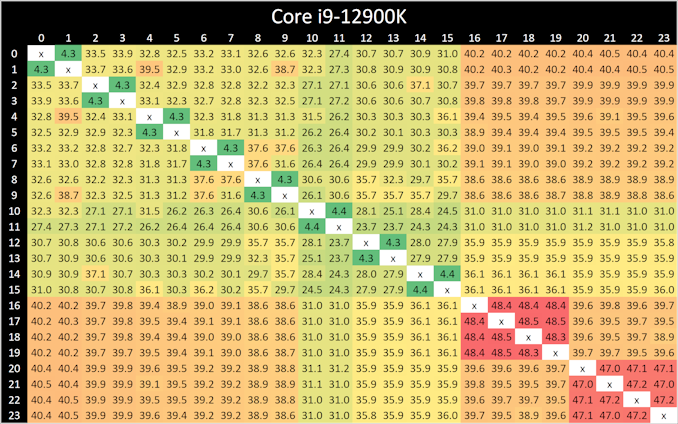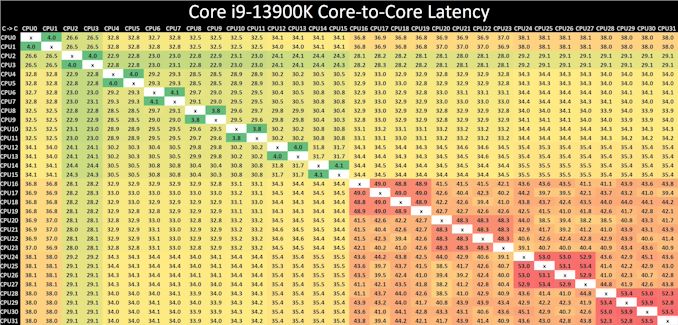Intel Core i9-13900K and i5-13600K Review: Raptor Lake Brings More Bite
by Gavin Bonshor on October 20, 2022 9:00 AM ESTCore-to-Core Latency
As the core count of modern CPUs is growing, we are reaching a time when the time to access each core from a different core is no longer a constant. Even before the advent of heterogeneous SoC designs, processors built on large rings or meshes can have different latencies to access the nearest core compared to the furthest core. This rings true especially in multi-socket server environments.
But modern CPUs, even desktop and consumer CPUs, can have variable access latency to get to another core. For example, in the first generation Threadripper CPUs, we had four chips on the package, each with 8 threads, and each with a different core-to-core latency depending on if it was on-die or off-die. This gets more complex with products like Lakefield, which has two different communication buses depending on which core is talking to which.
If you are a regular reader of AnandTech’s CPU reviews, you will recognize our Core-to-Core latency test. It’s a great way to show exactly how groups of cores are laid out on the silicon. This is a custom in-house test, and we know there are competing tests out there, but we feel ours is the most accurate to how quick an access between two cores can happen.

Looking at core-to-core latencies going from Alder Lake (12th Gen) to Raptor Lake (13th Gen), things look quite similar on the surface. The P-cores are listed within Windows 11 from cores 0 to 15, and in comparison to Alder Lake, latencies are much the same as what we saw when we reviewed the Core i9-12900K last year. The same comments apply here as with the Core i9-12900K, as we again see more of a bi-directional cache coherence.
Latencies between each Raptor Cove core have actually improved when compared to the Golden Cove cores on Alder Lake from 4.3/4.4 ns, down to 3.8/4.1 ns per each L1 access point.
The biggest difference is the doubling of the E-cores (Gracemont) on the Core i9-13900K, which as a consequence, adds more paths and crossovers. These paths do come with a harsher latency penalty than we saw with the Core i9-12900K, with latencies around the E-cores ranging from 48 to 54 ns within four core jumps between them; this is actually slower than it was on Alder Lake.
One possible reason for the negative latency is the 200 MHz reduction in base frequency on the Gracemont cores on Raptor Lake when compared with Alder Lake. When each E-core (Gracemont) core is communicating with each other, they travel through the L2 cache clusters via the L3 cache ring and back again, which does seem quite an inefficient way to go.











169 Comments
View All Comments
nandnandnand - Thursday, October 20, 2022 - link
The 7950X outperforms the 13900K from 65W to 185W by substantial amounts: https://www.youtube.com/watch?v=P40gp_DJk5E (19:00, Cinebench R23 multi)It also seems to use less power at lower temps in gaming (23:00, Cyberpunk 2077)
That's probably not the end of the story, but Zen 4 is clearly doing better out of the box. Good news for Dragon Range buyers in 2023. Reply
Harry_Wild - Thursday, October 20, 2022 - link
Very happy that Raptor Lake is super competitive to AMD 7000 series! AMD has to lower it’s high end pricing now for both it’s chipset and retail pricing. Let the price wars begin after Thanksgivings. I expect the 7050X to go from $699 to $499. X670E boards will be the same price as the Intel equivalent models! 😁👍 ReplyDrazick - Thursday, October 20, 2022 - link
Could you build / compiler the SPEC tests with AVX512 flags for the Ryzen 7xxx? ReplyRyan Smith - Thursday, October 20, 2022 - link
It's on the to-do list. Though we're not expecting a significant change in performance. ReplyKangal - Thursday, October 20, 2022 - link
Any plans to test these in thermally or energy-constrained limits? Like with Air Cooling, or certain Watt limits?Or perhaps, how will Zen4 on laptops compare to Intel's RPL-equivalent on laptops...?
From here it looks similar to Zen3 vs Intel 12th, or Zen2 vs Intel 11th. That AMD is competitive in multithread and better efficiency, and Intel only remains competitive by expending alot of power, and it's mostly for the single-core.
Reply
Ryan Smith - Friday, October 21, 2022 - link
Yes. Performance testing at lower power levels is also on the to-do list. We had a chance to play with eco mode a bit for the Ryzen review, but didn't get to do something similar for Raptor Lake. ReplyKangal - Friday, October 21, 2022 - link
Oh nice, will be waiting for that next article to drop. Cheers!Reply
m53 - Friday, October 21, 2022 - link
@Ryan: How about testing idle power and realistic day-to-day use cases? I can only find this kind of review for 12th gen vs Zen3 and not 13th gen vs zen4. Would be really nice to have the numbers for 13th zen vs zen4.Here is a link to the review for 12th gen vs zen3: https://youtu.be/4F2z3F64o94 Reply
Drazick - Friday, October 21, 2022 - link
@Ryan, I am not sure about it.I think enabling AVX512 on Ryzen will have a great effect on the FP tests of SPEC. Reply
Oxford Guy - Friday, October 28, 2022 - link
There wasn’t a delay when one of the rendering apps got AVX-512 support several years ago. Reply